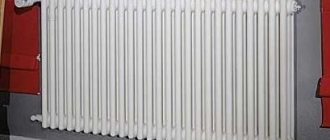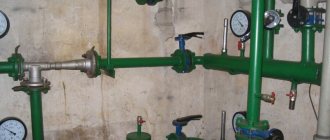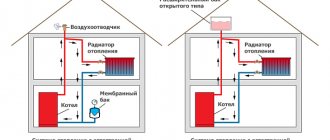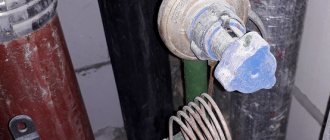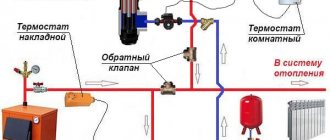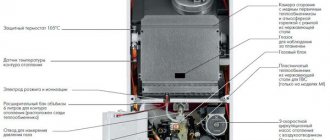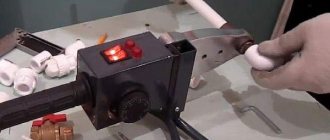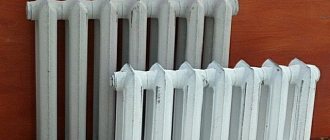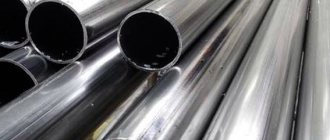Increase in pressure in the heating circuit
Now you know how to increase the pressure in the heating system, after first getting rid of the causes of the drop.
Next we will deal with its increase. If it constantly jumps, it means that the equipment is not operating in the correct mode. There may be other problems that will be discussed in this review. Sometimes the pressure indicator jumps just like that - this happens when some heating boilers operate with faulty sensors. But you still shouldn’t count on their incorrect operation, since inaction can lead to damage to the heating equipment. Most often, boilers suffer due to hydraulic overloads - heat exchangers and other internal components cannot withstand and burst.
A safety team will help prevent damage to the heating system due to high hydrodynamic loads. It is a mandatory element of every closed circuit. The group consists of the following parts:
The maximum pressure for most boilers is 3 atmospheres. Therefore, it is necessary to create conditions for their safe operation. The safety valve is responsible for this. Having opened, it will release part of the coolant and immediately close.
- Pressure gauge (or thermomanometer) – used to obtain control information.
- Air vent – removes air from the circuit.
- Safety valve – protects the circuit from hydraulic overloads.
The most important link here is the safety valve. It will automatically release pressure if it goes beyond dangerous limits. Typically, users do not pay any attention to pressure gauges. After all, you won’t monitor the indicators every hour for fear of an emergency. This is why a safety valve is a must – it is a simple and effective safety feature.
Eliminating the causes of growth
The presence of air pockets can cause a gradual increase in pressure in the heating circuit. They must be removed promptly. The simplest option is to use a manual air bleeder, which is installed next to the safety group. Mayevsky taps located on radiators are also used for this. Sometimes, to completely remove air, the coolant is changed and the system is refilled.
Too high a temperature is another reason for increased pressure. Typically, the temperature of the coolant in heating systems varies between +70-80 degrees, sometimes a little more, sometimes a little less. If for some reason it rises to higher levels, this will provoke expansion of the coolant. It will begin to put pressure on the pipes and radiators, causing the needle on the pressure gauge to creep up. To prevent an accident, it is necessary to allow the coolant to cool. After this, we understand the initial reasons for the rise in temperature.
A clogged heating circuit can also cause increased pressure in the system. The heating does not clog very often, but this cannot be ruled out. The cause of blockages is most often contaminated coolant - this is typical for systems with metal pipes that are subject to corrosion.
One of the reasons for the breakdown may be scale in the pipes. Usually, sections of pipes after blockages are colder - this is how we calculate the contaminated section.
Other reasons for increased pressure in the heating system:
- Users have messed with valves and valves - this is causing cold radiators.
- Constant replenishment of the circuit with water - this is necessary for the initial filling of the system or when the pressure drops; the rest of the time the water supply must be shut off.
- A breakdown of the circulation pump or its incorrect setting - excessive pressure is created along with an increase in pressure.
- Clogging of one or another circuit - blockages in individual “directions” can provoke a rise in pressure in the entire heating system.
All this knowledge is more than enough to maintain the correct coolant pressure in the heating system.
Heating pressure adjustment
In apartment buildings, the main problem associated with the functioning of the water supply system is low water pressure
This is especially important for tenants on upper floors and private homeowners. When the water supply is weak, household appliances do not work well - washing machines, dishwashers, bathtubs with built-in automation, sprinklers
Increase the voltage drop in the heating:
- installation and installation of pumping equipment that increases the intensity of the incoming water flow;
- equipment of a special pumping station, installation of a storage tank.
The choice of a method for increasing water tension is carried out taking into account the needs for a certain daily volume of supplied water by its consumer and the persons living with him.
Pumping equipment to increase the pressure of water supply to the apartment is inserted into the cold water supply system, after which it is adjusted.
To increase the water voltage in individual nodes of the autonomous water supply system, additional pumps can be installed at the disassembly points.
Features of using autonomous water supply systems
The specific features of the functioning of an autonomous water intake system include the need to collect and supply water from depths from a well or well, as well as ensuring normal water supply to all points and nodes of the water supply system, even in remote places.
When choosing a pump for autonomous water intake, it is necessary to take into account its performance, as well as the performance of the well itself. If the well productivity is low, the water pressure will naturally be insufficient to satisfy the domestic and economic needs of a private homeowner, and if it is large, it will lead to damage to equipment and household appliances, as well as the occurrence of leaks.
The installation of an autonomous pumping station requires the presence of a storage tank, which, together with a hydraulic accumulator, ensures the normal need for water at low system pressure or when it is completely absent from the water supply system.
In heating, pressure adjustment to the optimal level is carried out by turning special screws - regulators located under the pressure switch cover so that a voltage drop does not occur.
It should be remembered that the pumping station requires appropriate maintenance; it is necessary to regularly check the operation of the pump and other hydraulic elements and components, and clean the storage tank. When installing such equipment, it is necessary to take care in advance of sufficient space for its placement, ease of maintenance and repair. The large hydraulic accumulator itself can be buried in the ground, having previously made the necessary waterproofing, and installed in the basement or attic of a country house.
Why does blood pressure drop?
A decrease in pressure in a heating structure is observed very often. The most common causes of deviations are considered to be: the release of excess air, air escaping from the expansion tank, coolant leakage.
There is air in the system
Air has entered the heating circuit or there are air pockets in the batteries. Reasons for the appearance of air gaps:
- non-compliance with technical standards when filling the structure;
- excess air is not forcibly removed from the water supplied to the heating circuit;
- enrichment of the coolant with air due to leaky connections;
- malfunction of the air bleed valve.
If there are air cushions in the coolant, noise appears. This phenomenon causes damage to the components of the heating mechanism. In addition, the presence of air in the heating circuit units entails more serious consequences:
- vibration of the pipeline contributes to weakening of welds and displacement of threaded connections;
- the heating circuit is not ventilated, which leads to stagnation in isolated areas;
- The efficiency of the heating system decreases;
- there is a risk of “unfreezing”;
- There is a risk of damage to the pump impeller if air gets into it.
To eliminate the possibility of air entering the heating circuit, it is necessary to correctly put the circuit into operation, checking all elements for functionality.
Initially, testing is carried out with increased pressure. When performing pressure testing, the pressure in the system should not drop for 20 minutes.
For the first time, the circuit is filled with cold water, with the taps open to drain the water and the valves open to vent. The network pump is turned on at the very end. After removing the air, the amount of coolant required for operation is added to the circuit.
During operation, air may appear in the pipes; to get rid of it you need to:
- find an area with an air gap (in this place the pipe or battery is much colder);
- Having previously turned on the structure’s replenishment, open the valve or tap further downstream of the water and get rid of the air.
Air comes out of the expansion tank
The causes of problems with the expansion tank are as follows:
- installation error;
- incorrectly selected volume;
- nipple damage;
- membrane rupture.
Photo 3. Diagram of the expansion tank. The device may release air, causing the pressure in the heating system to drop.
All manipulations with the tank are carried out after disconnecting from the circuit. For repairs, it is necessary to completely remove water from the tank. Next, you should pump it up and bleed the air a little. Then, using a pump with a pressure gauge, bring the pressure level in the expansion tank to the required level, check for leaks and install it back on the circuit.
If the heating equipment is incorrectly configured, the following will be observed:
- increased pressure in the heating circuit and expansion tank;
- reducing the pressure to a critical level at which the boiler does not start;
- emergency releases of coolant with a constant need for replenishment.
Important! There are samples of expansion tanks on sale that do not have devices for adjusting pressure. It is better to avoid purchasing such models.
Flow
A leak in the heating circuit leads to a decrease in pressure and the need for constant replenishment. Liquid leakage from the heating circuit most often occurs from connecting joints and places affected by rust. It is not uncommon for liquid to escape through a torn expansion tank membrane.
You can determine the leak by pressing the nipple, which should allow only air to pass through. If a coolant loss location is detected, the problem must be corrected as soon as possible in order to avoid serious accidents.
Photo 4. Leak in the heating system pipes. This problem may cause your blood pressure to drop.
Why do pressure changes occur?
Pressure drops in the heating system - in the supply and outlet sections, on the upper and lower floors - arise for various reasons. Errors in design, defective equipment, natural wear and tear, non-compliance of operating conditions with design parameters, mechanical damage - all this leads to a violation of the technical parameters of the system.
The most common causes of fluctuations:
- leaks due to pipe ruptures or depressurization of connections;
- air pockets in various parts of the system;
- boiling of the coolant due to errors in design and operation.
Water leaks can occur due to the natural wear and tear of pipes and equipment, as well as due to a constant increase in operating pressure beyond the permissible parameters for the equipment. For example, residents in one of the apartments replaced standard heating radiators with new ones, without taking into account the design values. Having removed standard cast iron batteries and installed lighter bimetallic ones, after a while the owners discover leaks, because... The water pressure is too high for this type of radiator.
We recommend that you read: How to properly hide water pipes in the bathroom?
Airing of the system is another common phenomenon in which the oxygen contained in the water forms plugs (as a rule, in the areas where the riser passes to the batteries, in places where pipes turn). A characteristic sign of air pollution is the sound of water in the pipes.
Modern heating systems provide special engineering equipment (air valves, Mayevsky taps) to release air, which makes it easy to eliminate air pollution without the help of housing and communal services workers.
Boiling of the coolant is the most undesirable and dangerous scenario. Occurs for several reasons: due to too much boiler power, design errors, malfunction of the circulation pump, clogged water filters and in too narrow areas of the system.
It is important! Boiling coolant is fraught with water hammer - a sudden surge in pressure, which can lead to an emergency.
How to control the pressure in the system?
To control, pressure gauges are installed at various points of the heating system, and (as mentioned above) they record excess pressure. As a rule, these are deformation devices with a Bredan tube. If you need to take into account the fact that the pressure meter must work not only for visual control, but also in the automation system, electric contact or other types of sensors are used.
The insertion points are determined by regulatory documents, but even if you have installed a small boiler for heating a private house, which is not controlled by GosTechnadzor, it is still advisable to use these rules, since they highlight the most important points of the heating system for pressure control.
Pressure gauges must be installed through three-way valves, which ensure their purging, reset to zero and replacement without stopping the entire heating.
Control points are:
- Before and after the heating boiler;
- Before the entrance and after the circulation pumps;
- Output of heating networks from a heat generating unit (boiler house);
- Input of heating into the building;
- If a heating regulator is used, then pressure gauges are embedded before and after it;
- If there are mud traps or filters, it is advisable to install pressure gauges before and after them. Thus, it is easy to control their contamination, taking into account the fact that a working element creates almost no difference.
System with installed pressure gauges
A symptom of malfunctions or improper operation of the heating system is pressure surges. What do they mean?
Why is pressure needed?
Pressure in a heating system is the process of the coolant acting on the walls of the boiler, pipes, and radiators. Before water fills the pipeline, it is equal to atmospheric pressure (1 bar). This indicator changes as soon as the liquid begins to be poured into the pipeline and warms up. The coolant expands, the pressure increases to normal levels.
Reliable and efficient operation of a heating structure depends on pressure values. It provides it with extremely high performance and ensures that energy reaches the pipeline of all apartments in a multi-story building. This parameter determines the speed of water flow and, accordingly, the intensity of the heat exchange process between the structural components of the heating system. Therefore, the higher its performance, the greater the efficiency of the heating system.
Reasons for increasing power
An uncontrolled increase in pressure is an emergency.
May occur due to:
- the automatic control of the fuel supply process is faulty;
- the boiler operates in manual high-burning mode and is not switched to medium or low-burning;
- malfunction of the storage tank;
- malfunction of the fill valve.
The main reason is overheating of the coolant. What can be done?
- The operation of the boiler and automation should be checked. In manual mode, reduce the fuel supply.
- If the pressure gauge readings are critically high, drain some of the water until the readings drop into the work area. Next, check the readings.
- If no boiler malfunctions are identified, check the condition of the storage tank. It accepts a volume of water that increases when heated. If the damping rubber cuff of the tank is damaged, or there is no air in the air chamber, it will fill completely with water. When heated, the coolant will have nowhere to be displaced, and the increase in water pressure will be significant.
Checking the tank is easy. You need to press the nipple in the valve to fill the tank with air. If there is no air hissing, then the reason is a loss of air pressure. If water appears, the membrane is damaged.
A dangerous increase in power can lead to the following consequences:
- damage to heating elements, up to rupture;
- overheating of water, when a crack appears in the boiler structure, instantaneous vaporization will occur, releasing energy equal in power to an explosion;
- irreversible deformation of boiler and heating elements and rendering them unusable.
The most dangerous thing is a boiler explosion. At high pressure, water can heat up to a temperature of 140 C without boiling. When the slightest crack appears in the jacket of the boiler heat exchanger or even in the heating system next to the boiler, the pressure drops sharply.
Superheated water, with a sharp decrease in pressure, instantly boils with the formation of steam throughout the entire volume. The pressure instantly increases from steam formation, and this can lead to an explosion.
At high pressure and water temperature above 100 C, you cannot suddenly reduce power near the boiler. Do not fill the firebox with water: strong temperature changes may cause cracks.
It is necessary to take measures to lower the temperature and smoothly lower the pressure by draining the coolant in small portions at a point far from the boiler.
If the water temperature is below 95 C, adjusted for the thermometer error, then the pressure is reduced by releasing part of the water from the system. In this case, steam formation will not occur.
How to create and add pressure to a heating system
To create or add pressure in a heating system, several methods are used.
Crimping
Pressure testing is the process of initially filling the heating system with coolant, temporarily creating a pressure that exceeds the operating pressure.
Attention! For new systems, during commissioning, the pressure should be 2-3 times higher than normal, and during routine checks, an increase of 20-40% is sufficient. This operation can be performed in two ways:
This operation can be performed in two ways:
- Connecting the heating circuit to the water supply pipeline and gradually filling the system to the required values, controlled by a pressure gauge. This method will not work if the pressure in the water supply is not high enough.
- Use of manual or electric pumps. When there is already coolant in the circuit, but there is not enough pressure, special pressure testing pumps are used. Liquid is poured into the pump reservoir, and the pressure is brought to the required level.
Photo 1. The process of crimping the heating system. In this case, a manual pressure test pump is used.
Checking the heating main for tightness and leaks
The main purpose of pressure testing is to identify faulty elements of the heating system in the maximum operating mode in order to avoid accidents during further operation. Therefore, the next step after this procedure is to check all elements for leaks. Tightness control is carried out by the pressure drop over a certain time after pressure testing. The operation consists of two stages:
- Cold test, during which the circuit is filled with cold water. Within half an hour, the pressure level should not drop by more than 0.06 MPa. In 120 minutes the drop should be no more than 0.02 MPa.
- Hot check, the same procedure is carried out, only with hot water.
Based on the results of the fall, a conclusion is made about the tightness of the heating system. If the test is passed, the pressure level in the pipeline is reset to operating values by removing excess coolant.
Defining the concepts
First of all, let's look at the basic concepts that owners of private houses or apartments with autonomous heating should know:
- Working pressure is measured in bars, atmospheres or megapascals.
- The static pressure in the circuit is a constant value, that is, it does not change when the heating boiler is turned off. Static pressure in the heating system is created by the coolant circulating through the pipeline.
- The forces driving the coolant create dynamic pressure, which affects all components of the heating system from the inside.
- The permissible pressure level is the value at which the heating system can operate without breakdowns or accidents. Knowing what pressure should be in the heating boiler, you can maintain it at a given level. But exceeding this level threatens with unpleasant consequences.
- In the event of uncontrolled pressure surges in an autonomous heating system, the boiler radiator is the first to fail. As a rule, it can withstand no more than 3 atmospheres. As for batteries and pipes, depending on the material they are made of, they can cope with heavy loads. Therefore, the choice of battery must be made based on the type of system.
It is impossible to say unambiguously what the operating pressure is in a heating boiler, since this indicator is influenced by several other factors. In particular, this is the length of the heating circuit, the number of floors in the building, power and the number of batteries connected to a single system. The exact value of the working pressure is calculated during the creation of the project, taking into account the equipment and materials used.
Thus, the normal pressure in a heating boiler for houses on two or three floors is approximately 1.5-2 atmospheres. In higher residential buildings, it is allowed to increase the operating pressure to 2-4 atmospheres. For control, it is advisable to install pressure gauges.
Leak test
To ensure that the heating is reliable, after installation it is checked for leaks (pressure tested).
This can be done immediately on the entire structure or its individual elements. If a partial pressure test is carried out, then after its completion the entire system must be checked for leaks. Regardless of which heating system is installed (open or closed), the sequence of work will be almost the same.
Preparation
A test pressure is considered to be 1.5 times the working pressure. But this is not enough to completely detect a coolant leak. Pipes and couplings can withstand up to 25 atmospheres, so it is better to check the heating system under this pressure.
The corresponding indicators are created using a hand pump. There should be no air in the pipes: even a small amount of it will distort the tightness of the pipeline.
The highest pressure will be in the lowest place of the system; a monometer is installed there (reading accuracy 0.01 MPa).
Stage 1 - cold test
Over the course of half an hour, the pressure in the water-filled system is increased to the initial values. Do this twice, every 10-15 minutes. The fall will continue for another half hour, but without exceeding 0.06 MPa, and after two hours - 0.02 MPa.
At the end of the inspection, the pipeline is inspected for leaks.
Stage 2 - hot check
The first stage has been successfully completed, you can begin hot leak testing. To do this, connect a heating device, most often a boiler. Maximum performance indicators are established; they should not be greater than the calculated values.
Houses are preheated for at least 72 hours. The test is passed if no water leakage is detected.
Plastic pipeline
The plastic heating system is checked at the same temperature of the coolant in the pipeline and the environment. Changing these values will increase the pressure, but in fact there is a water leak in the system. For half an hour the pressure is maintained at a value one and a half times higher than the standard value. If necessary, pump it up slightly.
After 30 minutes, the pressure is sharply reduced to a reading equal to half the working one, and held for an hour and a half. If the indicators begin to increase, it means that the pipes are expanding and the structure is sealed.
Often, when checking a system, technicians perform a pressure drop several times, either increasing or decreasing it, so that it resembles normal, everyday working conditions. This method will help identify leaky connections.
Air test
Multi-storey buildings undergo airtightness testing in the fall. Instead of liquid in such cases, air can be used. The test results are slightly inaccurate due to the fact that the air is first heated during compression, then cooled, which contributes to a drop in pressure. Compressors will help increase this parameter.
The sequence for checking the heating system is as follows:
- The structure is filled with air (test values - 1.5 atmospheres).
- If a hiss is heard, it means there are defects, the pressure is reduced to atmospheric pressure and the defects are eliminated (for this, a foaming substance is used, it is applied to the joints).
- The pipeline is again filled with air (pressure - 1 atmosphere), held for 5 minutes.
Determining factors: expansion tank capacity, system type, etc.
The pressure in the heating system depends on several factors:
- Equipment power. Static is set by the height of a multi-story building or the rise of the expansion tank. The dynamic component is determined to a greater extent by the power of the circulation pump and, to a lesser extent, by the power of the heating boiler.
When ensuring the required pressure in the system, the appearance of obstacles to the movement of coolant in pipes and radiators is taken into account. During long-term use, scale, oxides and sediment accumulate in them. This leads to a decrease in diameter, which means an increase in resistance to fluid movement. This is especially noticeable with increased water hardness (mineralization). To eliminate the problem, periodically thoroughly flush the entire heating structure. In regions where water is hard, hot water purification filters are installed.
Normalization of working pressure in apartment buildings
Multi-storey buildings are connected to central heating, where the coolant is supplied from a thermal power plant, or to house boiler rooms. In modern heating systems, indicators are maintained in accordance with GOST and SNiP 41-01-2003. Normal pressure ensures a room temperature of 20–22 °C with a humidity of 30–45%.
Depending on the number of storeys of the building, the following standards are established:
- in houses up to 5 floors high 2-4 atm;
- in buildings up to 10 floors 4-7 atm;
- in buildings above 10 floors 8-12 atm.
It is important to ensure uniform heating of apartments located on different floors. The condition is considered normal when the difference between the operating pressures on the first and last floor of a multi-story building is no more than 8-10%
The condition is considered normal when the difference between the operating pressures on the first and last floor of a multi-story building is no more than 8-10%.
During periods when heating is not needed, the system maintains minimum levels. It is determined by the formula 0.1(Hx3+5+3), where N is the number of floors.
In addition to the number of floors of the building, the value depends on the temperature of the incoming coolant. Minimum values have been established: at 130 °C - 1.7-1.9 atm, at 140 °C - 2.6-2.8 atm. and at 150 °C - 3.8 atm.
Attention! Periodic performance checks play an important role in heating efficiency. They are controlled during the heating season and in the off-season
During operation, control is carried out using pressure gauges installed at the inlet and outlet of the heating circuit. At the inlet, the amount of incoming coolant must comply with established standards.
Check the pressure difference at the inlet and outlet. Normally, the difference is 0.1-0.2 atm. The absence of a drop indicates that there is no movement of water to the upper floors. An increase in the difference indicates the presence of coolant leaks.
In the warm season, the heating system is checked using pressure tests. Typically testing is provided by cold water pumped through. Depressurization of the system is detected when the indicators drop within 25-30 minutes by more than 0.07 MPa. The norm is a drop of 0.02 MPa within 1.5-2 hours.
Photo 1. The process of crimping the heating system. An electric pump is used, which is connected to the radiator.
What is the optimal pressure in a closed heating system?
The heating of “high-rise buildings”, which is provided according to a closed circuit, is discussed above. When arranging a closed system in private homes, there are nuances. Typically, circulation pumps are used that maintain the desired parameters. The main condition for their installation is that the pressure created should not exceed the values for which the heating boiler is designed (indicated in the equipment instructions).
At the same time, it must ensure the movement of coolant throughout the system, while the difference in water temperature at the outlet of the boiler and at the return point should not exceed 25-30 ° C.
For private, one-story buildings, the pressure in a closed heating system is considered to be within the range of 1.5-3 atm. The length of the pipeline during gravity flow is limited to 30 m, and when using a pump, the restriction is removed.
Features of open and closed heating systems
According to the design of the heating system in private houses, there can be:
- open - it is assumed that there is an expansion tank and a natural type of circulation of the coolant: when heated, it rises up, and as it cools down, it goes down;
- closed - the heating circuit is isolated from the external environment, and the coolant moves thanks to the circulation pump.
For the successful operation of open-type heating, it is necessary that the boiler be located at the lowest point, and the expansion tank at the highest. In this case, the cross-section of the pipes leaving the boiler must be larger than those entering on the return circuit. This system is used mainly in small one-story houses.
Closed type heating is much more common. In this case, the working pressure in the heating of a private closed house should be at the level of one and a half to two atmospheres, provided that the building is small and there are few batteries. If a private house has many rooms or has several floors, an additional circulation pump will be needed.
If the heating system is filled with water for the first time, air may enter the circuit. Once it is removed, the pressure in the system will drop slightly. It will need to be raised a little more, without, however, bringing it to the working value. As the water warms up, the pressure will increase.
Having a pump in a closed system makes it more efficient and economical. Depending on the power of the pump, the heating can be equipped with the required number of batteries and a pipeline of the required length. Radiators are connected in series or parallel (less load on the boiler).
In the off-season, a closed system with a pump allows you to regulate the degree of heating by setting minimum values.
